Counterfeit Media War: Social Media's Role in Political Discourse
VerifiedAdded on 2023/04/08
|11
|2483
|396
Report
AI Summary
This report delves into the intricate relationship between social media and political discourse, specifically exploring the concept of a 'counterfeit media war.' It examines how social media platforms serve as powerful tools for individuals and communities to voice their opinions, challenge government policies, and influence public opinion. The report highlights the role of influencers in shaping these narratives, acting as catalysts for both positive and negative campaigns. It also explores the historical context of media usage and its evolution, categorizing social media platforms and analyzing their impact on transparency, credibility, and the overall political landscape. The report further draws parallels between collective bargaining in labor relations and the dynamics of social media, emphasizing how social media empowers citizens to express grievances and concerns regarding government actions. The study concludes by underscoring the importance of understanding the effects of social media in the modern era and its capacity to both wage and diffuse conflicts, ultimately affecting the actions of government bodies.
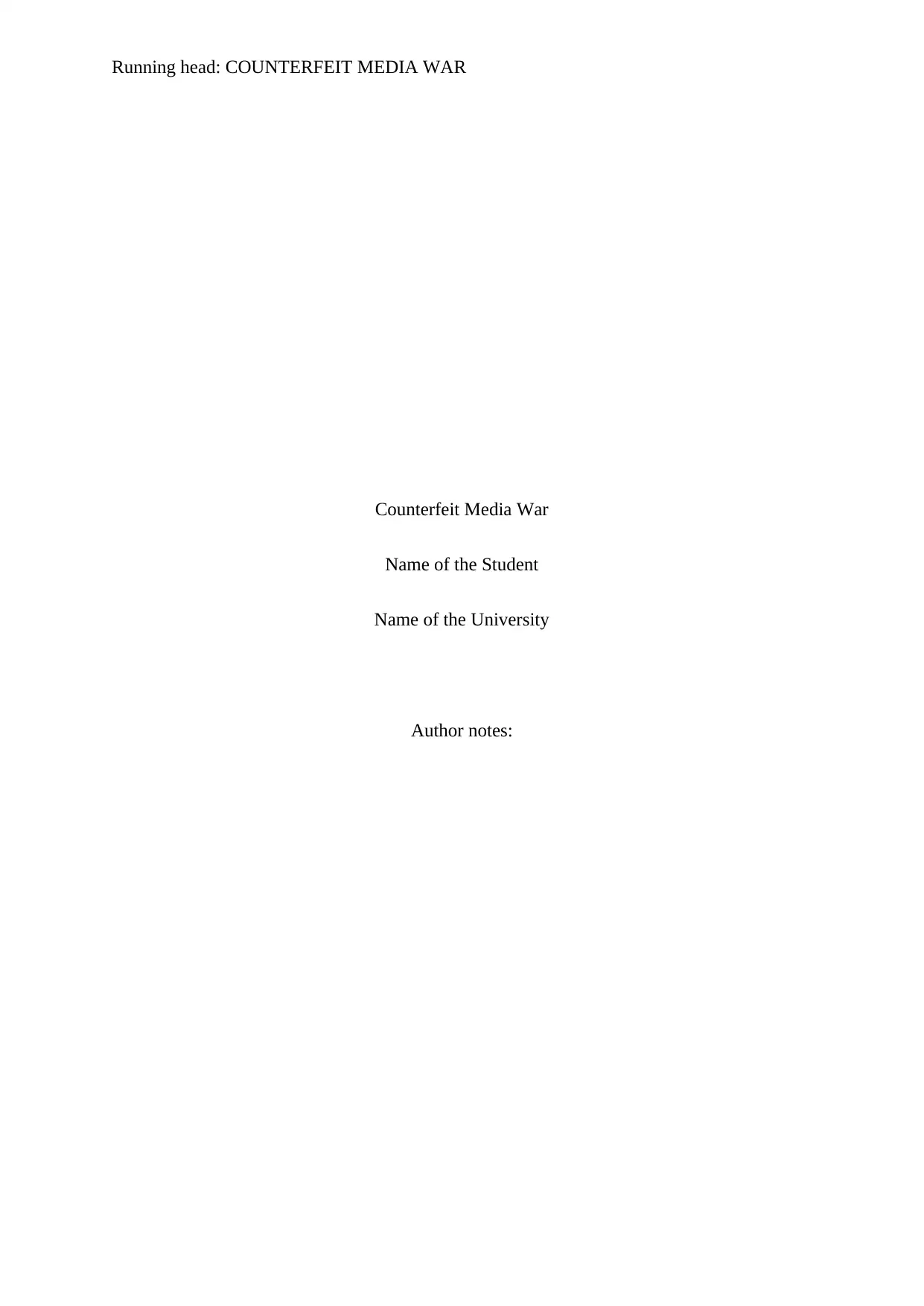
Running head: COUNTERFEIT MEDIA WAR
Counterfeit Media War
Name of the Student
Name of the University
Author notes:
Counterfeit Media War
Name of the Student
Name of the University
Author notes:
Paraphrase This Document
Need a fresh take? Get an instant paraphrase of this document with our AI Paraphraser
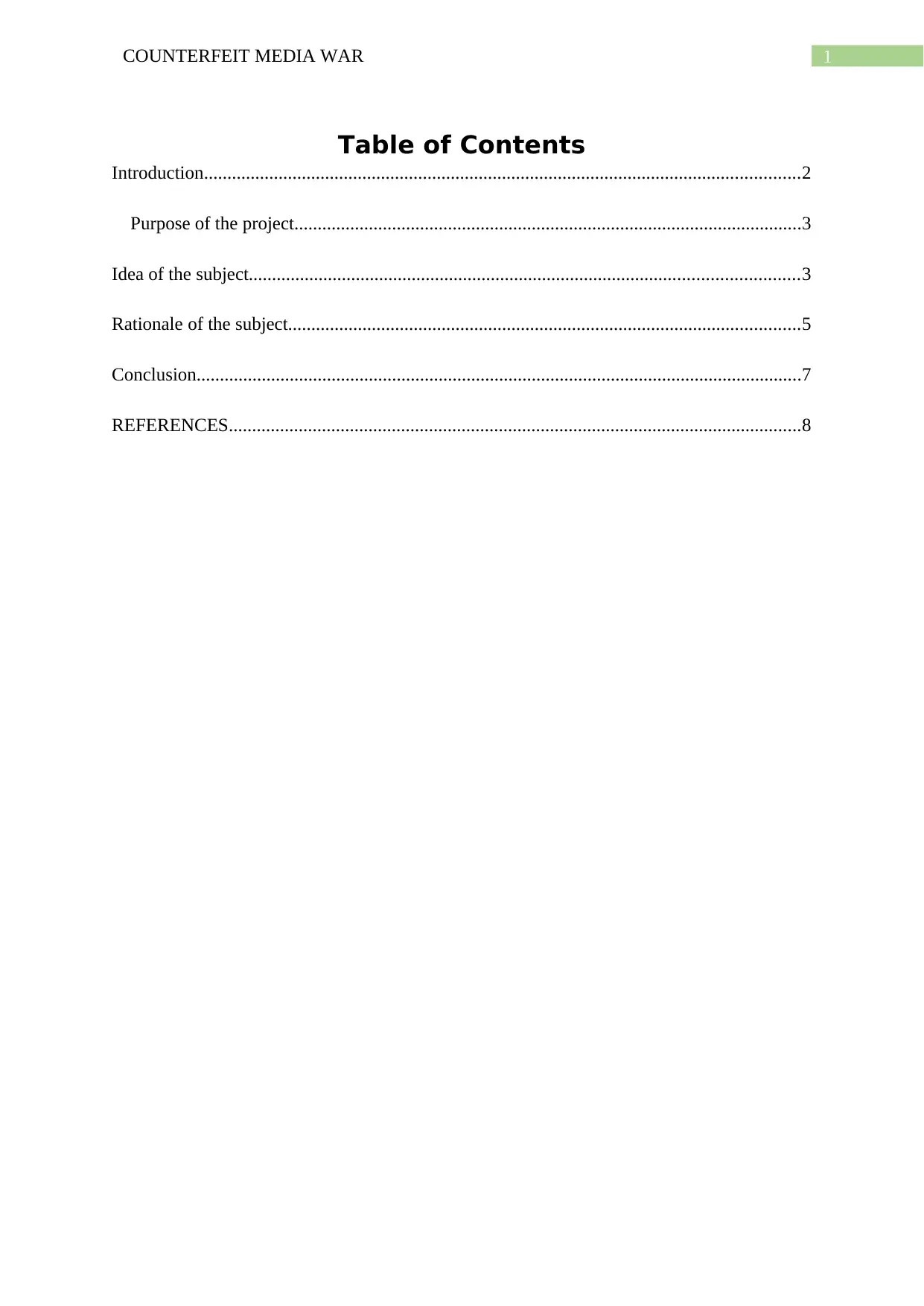
1COUNTERFEIT MEDIA WAR
Table of Contents
Introduction................................................................................................................................2
Purpose of the project.............................................................................................................3
Idea of the subject......................................................................................................................3
Rationale of the subject..............................................................................................................5
Conclusion..................................................................................................................................7
REFERENCES...........................................................................................................................8
Table of Contents
Introduction................................................................................................................................2
Purpose of the project.............................................................................................................3
Idea of the subject......................................................................................................................3
Rationale of the subject..............................................................................................................5
Conclusion..................................................................................................................................7
REFERENCES...........................................................................................................................8
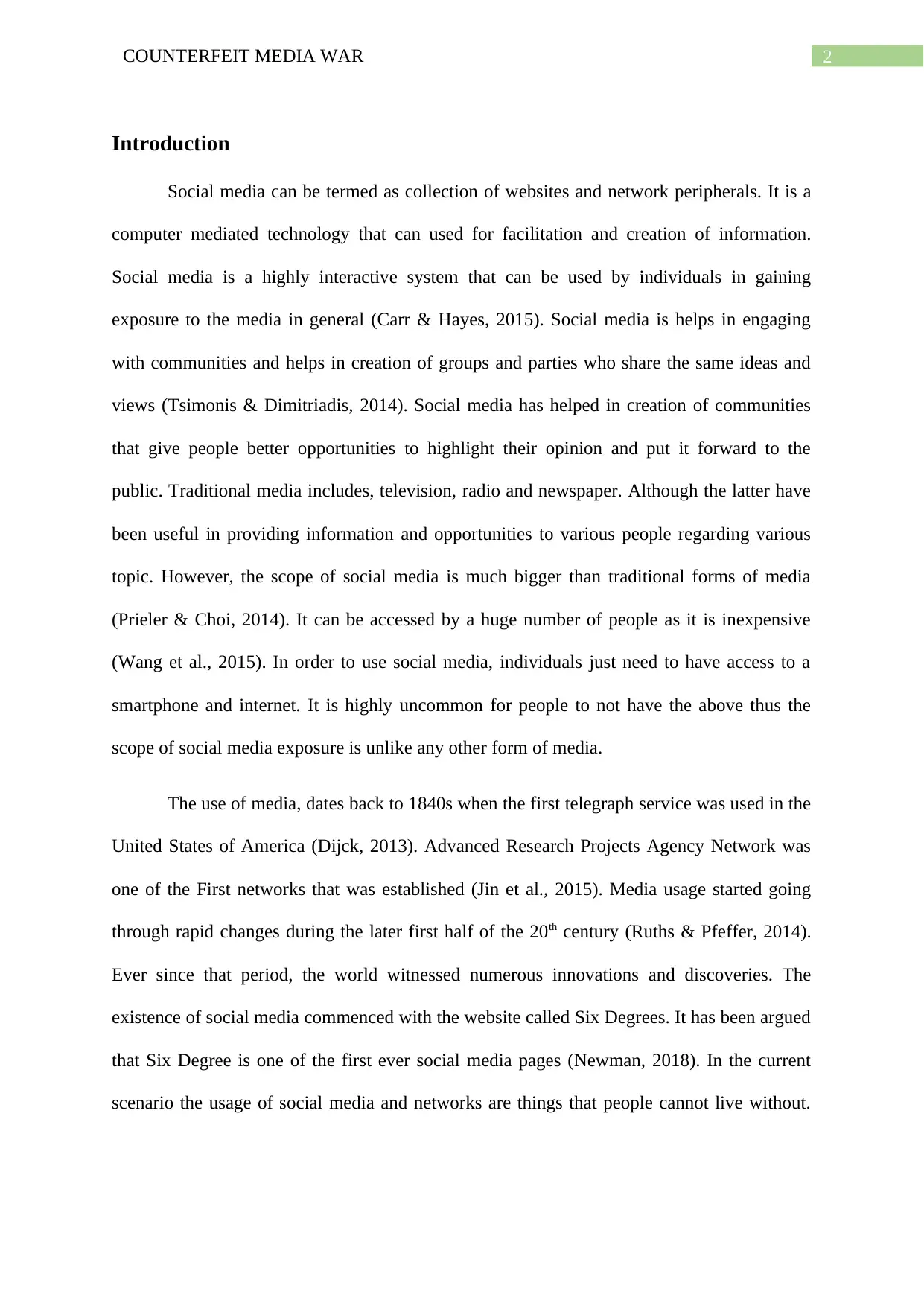
2COUNTERFEIT MEDIA WAR
Introduction
Social media can be termed as collection of websites and network peripherals. It is a
computer mediated technology that can used for facilitation and creation of information.
Social media is a highly interactive system that can be used by individuals in gaining
exposure to the media in general (Carr & Hayes, 2015). Social media is helps in engaging
with communities and helps in creation of groups and parties who share the same ideas and
views (Tsimonis & Dimitriadis, 2014). Social media has helped in creation of communities
that give people better opportunities to highlight their opinion and put it forward to the
public. Traditional media includes, television, radio and newspaper. Although the latter have
been useful in providing information and opportunities to various people regarding various
topic. However, the scope of social media is much bigger than traditional forms of media
(Prieler & Choi, 2014). It can be accessed by a huge number of people as it is inexpensive
(Wang et al., 2015). In order to use social media, individuals just need to have access to a
smartphone and internet. It is highly uncommon for people to not have the above thus the
scope of social media exposure is unlike any other form of media.
The use of media, dates back to 1840s when the first telegraph service was used in the
United States of America (Dijck, 2013). Advanced Research Projects Agency Network was
one of the First networks that was established (Jin et al., 2015). Media usage started going
through rapid changes during the later first half of the 20th century (Ruths & Pfeffer, 2014).
Ever since that period, the world witnessed numerous innovations and discoveries. The
existence of social media commenced with the website called Six Degrees. It has been argued
that Six Degree is one of the first ever social media pages (Newman, 2018). In the current
scenario the usage of social media and networks are things that people cannot live without.
Introduction
Social media can be termed as collection of websites and network peripherals. It is a
computer mediated technology that can used for facilitation and creation of information.
Social media is a highly interactive system that can be used by individuals in gaining
exposure to the media in general (Carr & Hayes, 2015). Social media is helps in engaging
with communities and helps in creation of groups and parties who share the same ideas and
views (Tsimonis & Dimitriadis, 2014). Social media has helped in creation of communities
that give people better opportunities to highlight their opinion and put it forward to the
public. Traditional media includes, television, radio and newspaper. Although the latter have
been useful in providing information and opportunities to various people regarding various
topic. However, the scope of social media is much bigger than traditional forms of media
(Prieler & Choi, 2014). It can be accessed by a huge number of people as it is inexpensive
(Wang et al., 2015). In order to use social media, individuals just need to have access to a
smartphone and internet. It is highly uncommon for people to not have the above thus the
scope of social media exposure is unlike any other form of media.
The use of media, dates back to 1840s when the first telegraph service was used in the
United States of America (Dijck, 2013). Advanced Research Projects Agency Network was
one of the First networks that was established (Jin et al., 2015). Media usage started going
through rapid changes during the later first half of the 20th century (Ruths & Pfeffer, 2014).
Ever since that period, the world witnessed numerous innovations and discoveries. The
existence of social media commenced with the website called Six Degrees. It has been argued
that Six Degree is one of the first ever social media pages (Newman, 2018). In the current
scenario the usage of social media and networks are things that people cannot live without.
⊘ This is a preview!⊘
Do you want full access?
Subscribe today to unlock all pages.

Trusted by 1+ million students worldwide
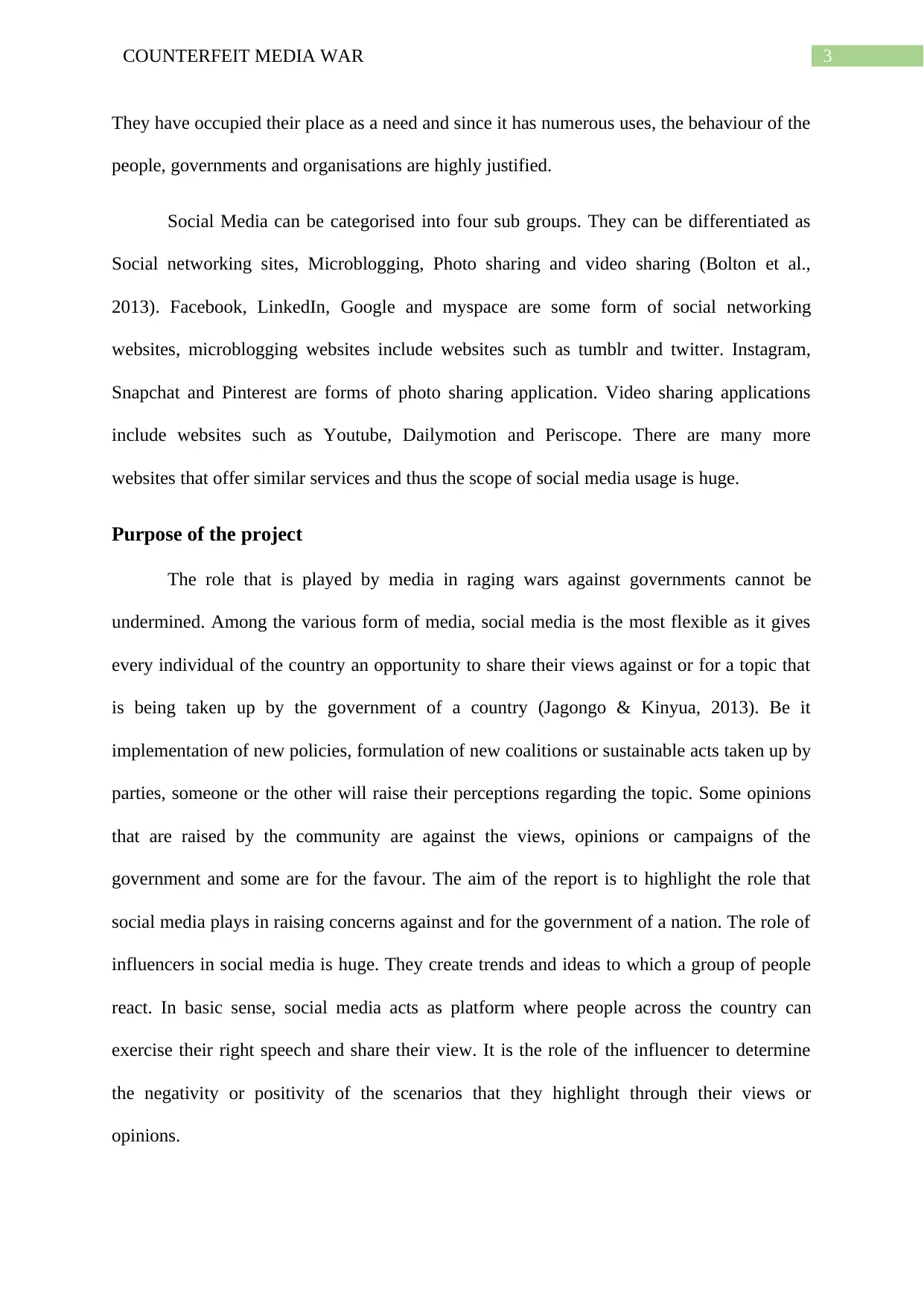
3COUNTERFEIT MEDIA WAR
They have occupied their place as a need and since it has numerous uses, the behaviour of the
people, governments and organisations are highly justified.
Social Media can be categorised into four sub groups. They can be differentiated as
Social networking sites, Microblogging, Photo sharing and video sharing (Bolton et al.,
2013). Facebook, LinkedIn, Google and myspace are some form of social networking
websites, microblogging websites include websites such as tumblr and twitter. Instagram,
Snapchat and Pinterest are forms of photo sharing application. Video sharing applications
include websites such as Youtube, Dailymotion and Periscope. There are many more
websites that offer similar services and thus the scope of social media usage is huge.
Purpose of the project
The role that is played by media in raging wars against governments cannot be
undermined. Among the various form of media, social media is the most flexible as it gives
every individual of the country an opportunity to share their views against or for a topic that
is being taken up by the government of a country (Jagongo & Kinyua, 2013). Be it
implementation of new policies, formulation of new coalitions or sustainable acts taken up by
parties, someone or the other will raise their perceptions regarding the topic. Some opinions
that are raised by the community are against the views, opinions or campaigns of the
government and some are for the favour. The aim of the report is to highlight the role that
social media plays in raising concerns against and for the government of a nation. The role of
influencers in social media is huge. They create trends and ideas to which a group of people
react. In basic sense, social media acts as platform where people across the country can
exercise their right speech and share their view. It is the role of the influencer to determine
the negativity or positivity of the scenarios that they highlight through their views or
opinions.
They have occupied their place as a need and since it has numerous uses, the behaviour of the
people, governments and organisations are highly justified.
Social Media can be categorised into four sub groups. They can be differentiated as
Social networking sites, Microblogging, Photo sharing and video sharing (Bolton et al.,
2013). Facebook, LinkedIn, Google and myspace are some form of social networking
websites, microblogging websites include websites such as tumblr and twitter. Instagram,
Snapchat and Pinterest are forms of photo sharing application. Video sharing applications
include websites such as Youtube, Dailymotion and Periscope. There are many more
websites that offer similar services and thus the scope of social media usage is huge.
Purpose of the project
The role that is played by media in raging wars against governments cannot be
undermined. Among the various form of media, social media is the most flexible as it gives
every individual of the country an opportunity to share their views against or for a topic that
is being taken up by the government of a country (Jagongo & Kinyua, 2013). Be it
implementation of new policies, formulation of new coalitions or sustainable acts taken up by
parties, someone or the other will raise their perceptions regarding the topic. Some opinions
that are raised by the community are against the views, opinions or campaigns of the
government and some are for the favour. The aim of the report is to highlight the role that
social media plays in raising concerns against and for the government of a nation. The role of
influencers in social media is huge. They create trends and ideas to which a group of people
react. In basic sense, social media acts as platform where people across the country can
exercise their right speech and share their view. It is the role of the influencer to determine
the negativity or positivity of the scenarios that they highlight through their views or
opinions.
Paraphrase This Document
Need a fresh take? Get an instant paraphrase of this document with our AI Paraphraser
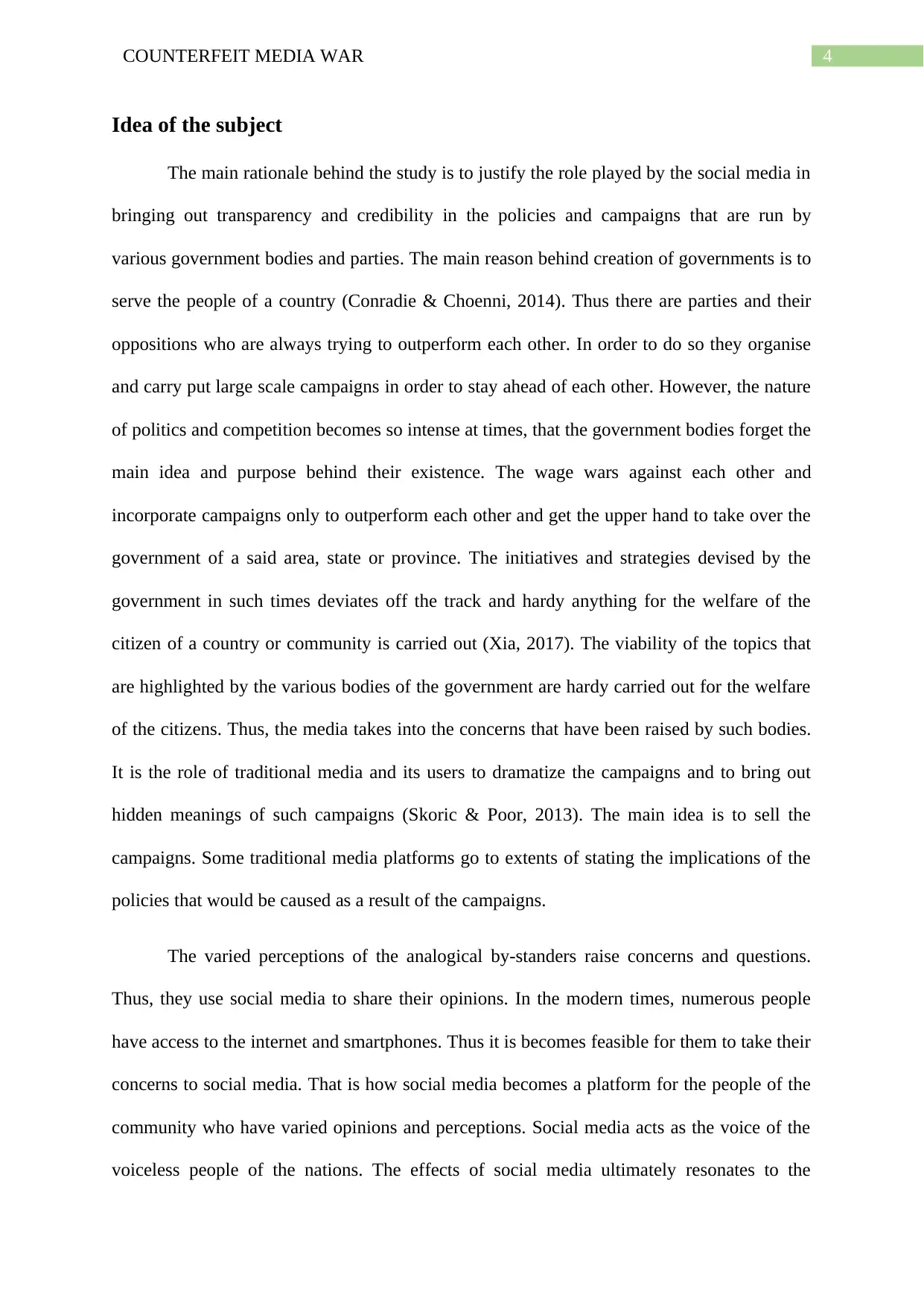
4COUNTERFEIT MEDIA WAR
Idea of the subject
The main rationale behind the study is to justify the role played by the social media in
bringing out transparency and credibility in the policies and campaigns that are run by
various government bodies and parties. The main reason behind creation of governments is to
serve the people of a country (Conradie & Choenni, 2014). Thus there are parties and their
oppositions who are always trying to outperform each other. In order to do so they organise
and carry put large scale campaigns in order to stay ahead of each other. However, the nature
of politics and competition becomes so intense at times, that the government bodies forget the
main idea and purpose behind their existence. The wage wars against each other and
incorporate campaigns only to outperform each other and get the upper hand to take over the
government of a said area, state or province. The initiatives and strategies devised by the
government in such times deviates off the track and hardy anything for the welfare of the
citizen of a country or community is carried out (Xia, 2017). The viability of the topics that
are highlighted by the various bodies of the government are hardy carried out for the welfare
of the citizens. Thus, the media takes into the concerns that have been raised by such bodies.
It is the role of traditional media and its users to dramatize the campaigns and to bring out
hidden meanings of such campaigns (Skoric & Poor, 2013). The main idea is to sell the
campaigns. Some traditional media platforms go to extents of stating the implications of the
policies that would be caused as a result of the campaigns.
The varied perceptions of the analogical by-standers raise concerns and questions.
Thus, they use social media to share their opinions. In the modern times, numerous people
have access to the internet and smartphones. Thus it is becomes feasible for them to take their
concerns to social media. That is how social media becomes a platform for the people of the
community who have varied opinions and perceptions. Social media acts as the voice of the
voiceless people of the nations. The effects of social media ultimately resonates to the
Idea of the subject
The main rationale behind the study is to justify the role played by the social media in
bringing out transparency and credibility in the policies and campaigns that are run by
various government bodies and parties. The main reason behind creation of governments is to
serve the people of a country (Conradie & Choenni, 2014). Thus there are parties and their
oppositions who are always trying to outperform each other. In order to do so they organise
and carry put large scale campaigns in order to stay ahead of each other. However, the nature
of politics and competition becomes so intense at times, that the government bodies forget the
main idea and purpose behind their existence. The wage wars against each other and
incorporate campaigns only to outperform each other and get the upper hand to take over the
government of a said area, state or province. The initiatives and strategies devised by the
government in such times deviates off the track and hardy anything for the welfare of the
citizen of a country or community is carried out (Xia, 2017). The viability of the topics that
are highlighted by the various bodies of the government are hardy carried out for the welfare
of the citizens. Thus, the media takes into the concerns that have been raised by such bodies.
It is the role of traditional media and its users to dramatize the campaigns and to bring out
hidden meanings of such campaigns (Skoric & Poor, 2013). The main idea is to sell the
campaigns. Some traditional media platforms go to extents of stating the implications of the
policies that would be caused as a result of the campaigns.
The varied perceptions of the analogical by-standers raise concerns and questions.
Thus, they use social media to share their opinions. In the modern times, numerous people
have access to the internet and smartphones. Thus it is becomes feasible for them to take their
concerns to social media. That is how social media becomes a platform for the people of the
community who have varied opinions and perceptions. Social media acts as the voice of the
voiceless people of the nations. The effects of social media ultimately resonates to the
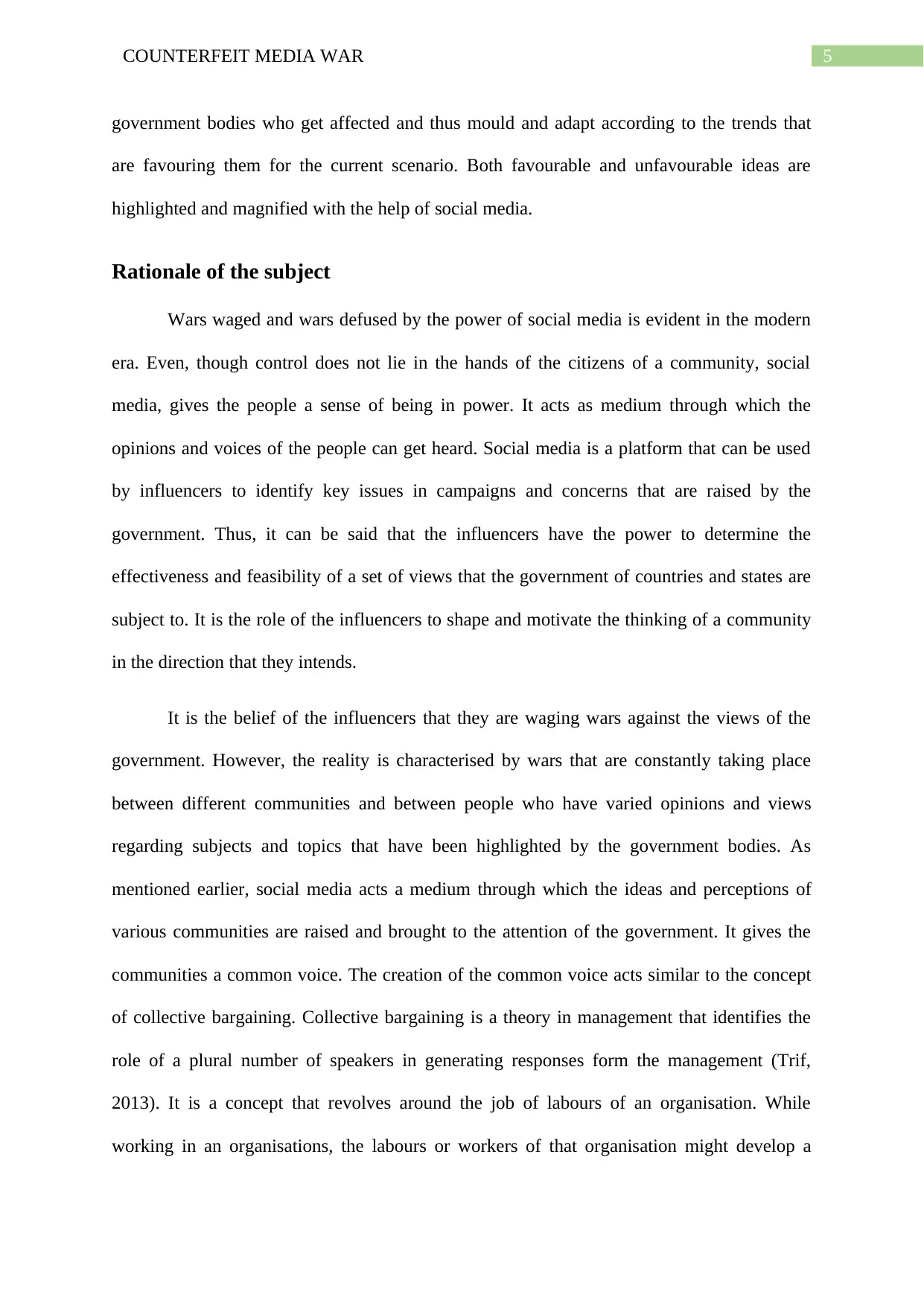
5COUNTERFEIT MEDIA WAR
government bodies who get affected and thus mould and adapt according to the trends that
are favouring them for the current scenario. Both favourable and unfavourable ideas are
highlighted and magnified with the help of social media.
Rationale of the subject
Wars waged and wars defused by the power of social media is evident in the modern
era. Even, though control does not lie in the hands of the citizens of a community, social
media, gives the people a sense of being in power. It acts as medium through which the
opinions and voices of the people can get heard. Social media is a platform that can be used
by influencers to identify key issues in campaigns and concerns that are raised by the
government. Thus, it can be said that the influencers have the power to determine the
effectiveness and feasibility of a set of views that the government of countries and states are
subject to. It is the role of the influencers to shape and motivate the thinking of a community
in the direction that they intends.
It is the belief of the influencers that they are waging wars against the views of the
government. However, the reality is characterised by wars that are constantly taking place
between different communities and between people who have varied opinions and views
regarding subjects and topics that have been highlighted by the government bodies. As
mentioned earlier, social media acts a medium through which the ideas and perceptions of
various communities are raised and brought to the attention of the government. It gives the
communities a common voice. The creation of the common voice acts similar to the concept
of collective bargaining. Collective bargaining is a theory in management that identifies the
role of a plural number of speakers in generating responses form the management (Trif,
2013). It is a concept that revolves around the job of labours of an organisation. While
working in an organisations, the labours or workers of that organisation might develop a
government bodies who get affected and thus mould and adapt according to the trends that
are favouring them for the current scenario. Both favourable and unfavourable ideas are
highlighted and magnified with the help of social media.
Rationale of the subject
Wars waged and wars defused by the power of social media is evident in the modern
era. Even, though control does not lie in the hands of the citizens of a community, social
media, gives the people a sense of being in power. It acts as medium through which the
opinions and voices of the people can get heard. Social media is a platform that can be used
by influencers to identify key issues in campaigns and concerns that are raised by the
government. Thus, it can be said that the influencers have the power to determine the
effectiveness and feasibility of a set of views that the government of countries and states are
subject to. It is the role of the influencers to shape and motivate the thinking of a community
in the direction that they intends.
It is the belief of the influencers that they are waging wars against the views of the
government. However, the reality is characterised by wars that are constantly taking place
between different communities and between people who have varied opinions and views
regarding subjects and topics that have been highlighted by the government bodies. As
mentioned earlier, social media acts a medium through which the ideas and perceptions of
various communities are raised and brought to the attention of the government. It gives the
communities a common voice. The creation of the common voice acts similar to the concept
of collective bargaining. Collective bargaining is a theory in management that identifies the
role of a plural number of speakers in generating responses form the management (Trif,
2013). It is a concept that revolves around the job of labours of an organisation. While
working in an organisations, the labours or workers of that organisation might develop a
⊘ This is a preview!⊘
Do you want full access?
Subscribe today to unlock all pages.

Trusted by 1+ million students worldwide
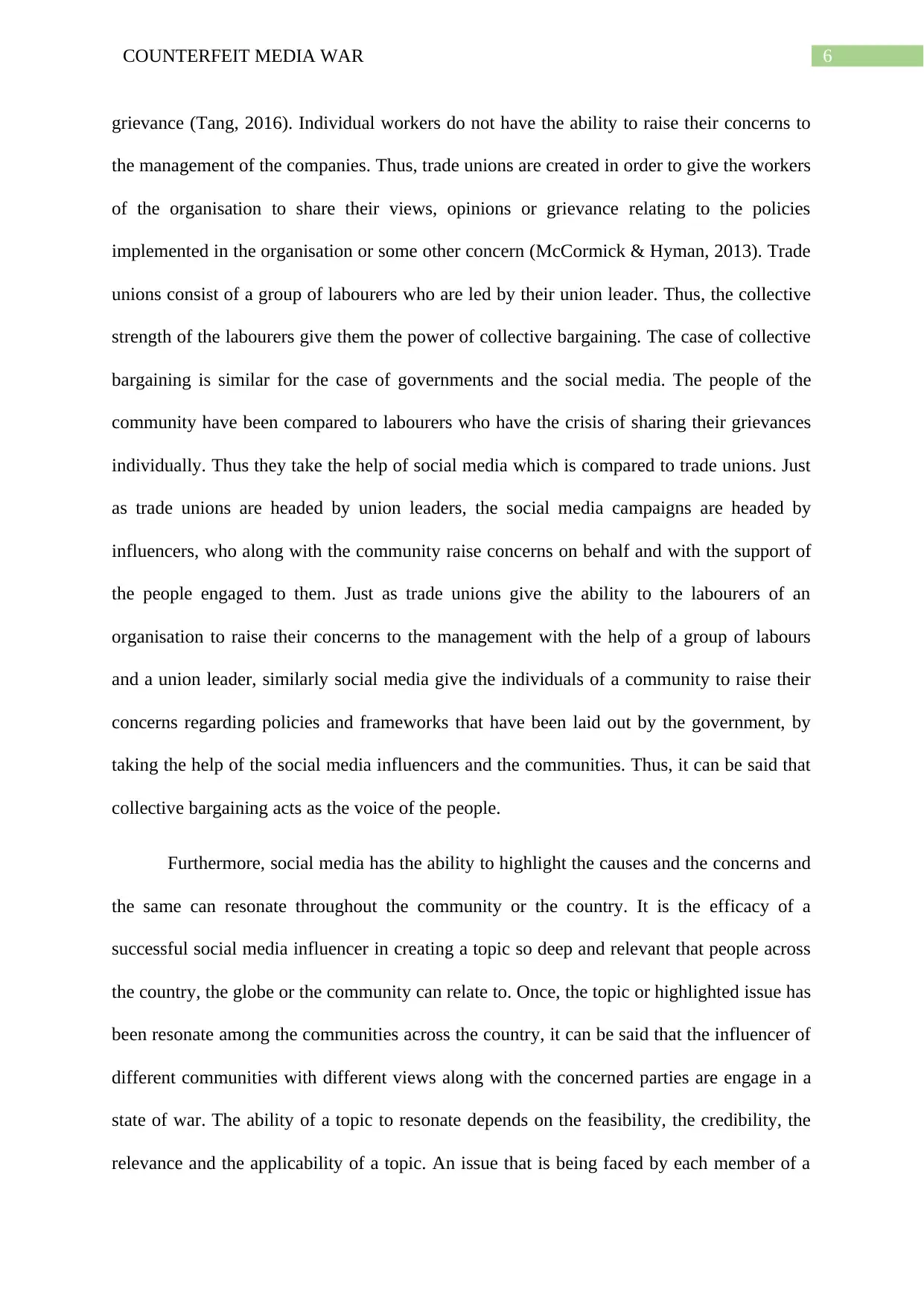
6COUNTERFEIT MEDIA WAR
grievance (Tang, 2016). Individual workers do not have the ability to raise their concerns to
the management of the companies. Thus, trade unions are created in order to give the workers
of the organisation to share their views, opinions or grievance relating to the policies
implemented in the organisation or some other concern (McCormick & Hyman, 2013). Trade
unions consist of a group of labourers who are led by their union leader. Thus, the collective
strength of the labourers give them the power of collective bargaining. The case of collective
bargaining is similar for the case of governments and the social media. The people of the
community have been compared to labourers who have the crisis of sharing their grievances
individually. Thus they take the help of social media which is compared to trade unions. Just
as trade unions are headed by union leaders, the social media campaigns are headed by
influencers, who along with the community raise concerns on behalf and with the support of
the people engaged to them. Just as trade unions give the ability to the labourers of an
organisation to raise their concerns to the management with the help of a group of labours
and a union leader, similarly social media give the individuals of a community to raise their
concerns regarding policies and frameworks that have been laid out by the government, by
taking the help of the social media influencers and the communities. Thus, it can be said that
collective bargaining acts as the voice of the people.
Furthermore, social media has the ability to highlight the causes and the concerns and
the same can resonate throughout the community or the country. It is the efficacy of a
successful social media influencer in creating a topic so deep and relevant that people across
the country, the globe or the community can relate to. Once, the topic or highlighted issue has
been resonate among the communities across the country, it can be said that the influencer of
different communities with different views along with the concerned parties are engage in a
state of war. The ability of a topic to resonate depends on the feasibility, the credibility, the
relevance and the applicability of a topic. An issue that is being faced by each member of a
grievance (Tang, 2016). Individual workers do not have the ability to raise their concerns to
the management of the companies. Thus, trade unions are created in order to give the workers
of the organisation to share their views, opinions or grievance relating to the policies
implemented in the organisation or some other concern (McCormick & Hyman, 2013). Trade
unions consist of a group of labourers who are led by their union leader. Thus, the collective
strength of the labourers give them the power of collective bargaining. The case of collective
bargaining is similar for the case of governments and the social media. The people of the
community have been compared to labourers who have the crisis of sharing their grievances
individually. Thus they take the help of social media which is compared to trade unions. Just
as trade unions are headed by union leaders, the social media campaigns are headed by
influencers, who along with the community raise concerns on behalf and with the support of
the people engaged to them. Just as trade unions give the ability to the labourers of an
organisation to raise their concerns to the management with the help of a group of labours
and a union leader, similarly social media give the individuals of a community to raise their
concerns regarding policies and frameworks that have been laid out by the government, by
taking the help of the social media influencers and the communities. Thus, it can be said that
collective bargaining acts as the voice of the people.
Furthermore, social media has the ability to highlight the causes and the concerns and
the same can resonate throughout the community or the country. It is the efficacy of a
successful social media influencer in creating a topic so deep and relevant that people across
the country, the globe or the community can relate to. Once, the topic or highlighted issue has
been resonate among the communities across the country, it can be said that the influencer of
different communities with different views along with the concerned parties are engage in a
state of war. The ability of a topic to resonate depends on the feasibility, the credibility, the
relevance and the applicability of a topic. An issue that is being faced by each member of a
Paraphrase This Document
Need a fresh take? Get an instant paraphrase of this document with our AI Paraphraser
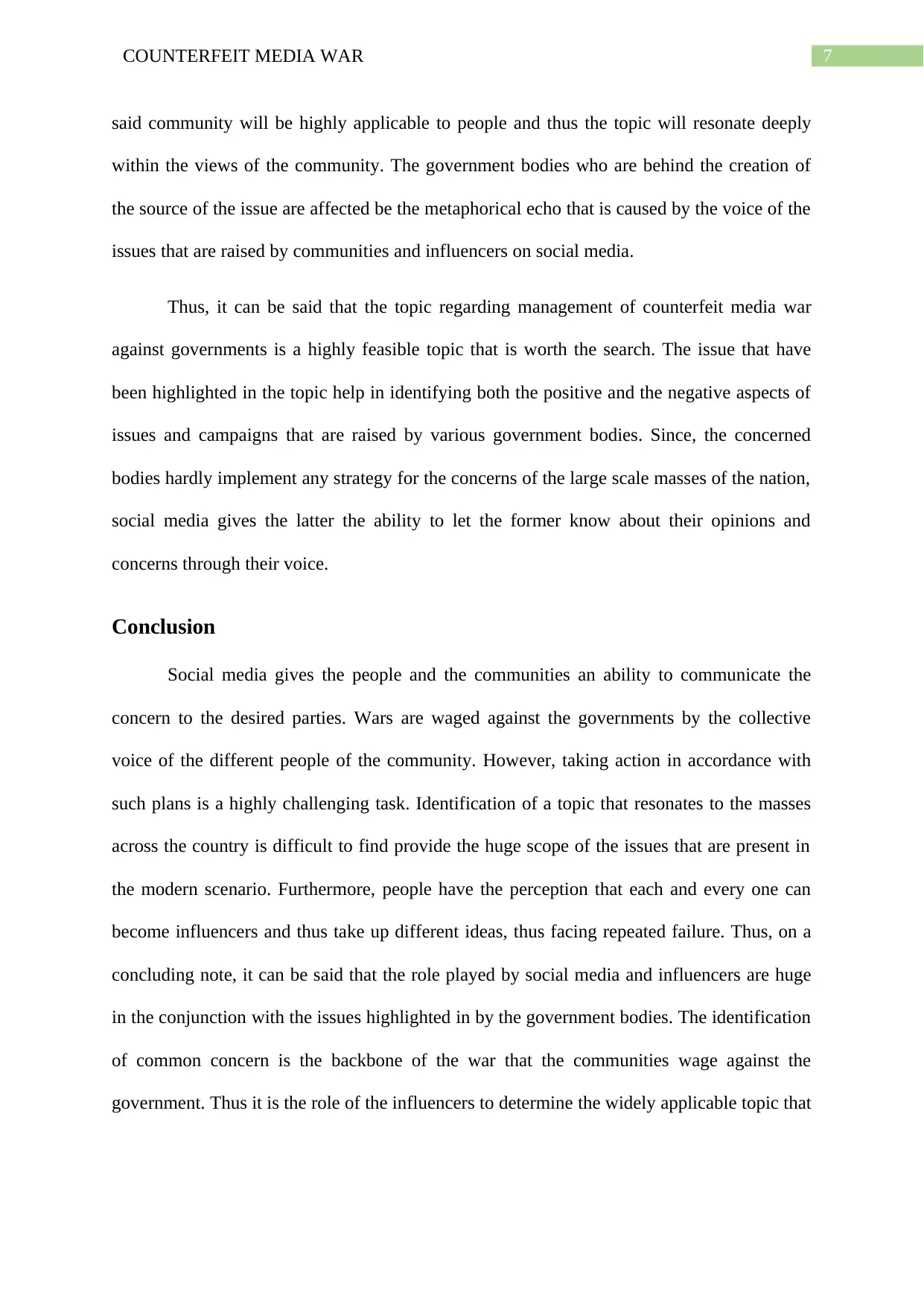
7COUNTERFEIT MEDIA WAR
said community will be highly applicable to people and thus the topic will resonate deeply
within the views of the community. The government bodies who are behind the creation of
the source of the issue are affected be the metaphorical echo that is caused by the voice of the
issues that are raised by communities and influencers on social media.
Thus, it can be said that the topic regarding management of counterfeit media war
against governments is a highly feasible topic that is worth the search. The issue that have
been highlighted in the topic help in identifying both the positive and the negative aspects of
issues and campaigns that are raised by various government bodies. Since, the concerned
bodies hardly implement any strategy for the concerns of the large scale masses of the nation,
social media gives the latter the ability to let the former know about their opinions and
concerns through their voice.
Conclusion
Social media gives the people and the communities an ability to communicate the
concern to the desired parties. Wars are waged against the governments by the collective
voice of the different people of the community. However, taking action in accordance with
such plans is a highly challenging task. Identification of a topic that resonates to the masses
across the country is difficult to find provide the huge scope of the issues that are present in
the modern scenario. Furthermore, people have the perception that each and every one can
become influencers and thus take up different ideas, thus facing repeated failure. Thus, on a
concluding note, it can be said that the role played by social media and influencers are huge
in the conjunction with the issues highlighted in by the government bodies. The identification
of common concern is the backbone of the war that the communities wage against the
government. Thus it is the role of the influencers to determine the widely applicable topic that
said community will be highly applicable to people and thus the topic will resonate deeply
within the views of the community. The government bodies who are behind the creation of
the source of the issue are affected be the metaphorical echo that is caused by the voice of the
issues that are raised by communities and influencers on social media.
Thus, it can be said that the topic regarding management of counterfeit media war
against governments is a highly feasible topic that is worth the search. The issue that have
been highlighted in the topic help in identifying both the positive and the negative aspects of
issues and campaigns that are raised by various government bodies. Since, the concerned
bodies hardly implement any strategy for the concerns of the large scale masses of the nation,
social media gives the latter the ability to let the former know about their opinions and
concerns through their voice.
Conclusion
Social media gives the people and the communities an ability to communicate the
concern to the desired parties. Wars are waged against the governments by the collective
voice of the different people of the community. However, taking action in accordance with
such plans is a highly challenging task. Identification of a topic that resonates to the masses
across the country is difficult to find provide the huge scope of the issues that are present in
the modern scenario. Furthermore, people have the perception that each and every one can
become influencers and thus take up different ideas, thus facing repeated failure. Thus, on a
concluding note, it can be said that the role played by social media and influencers are huge
in the conjunction with the issues highlighted in by the government bodies. The identification
of common concern is the backbone of the war that the communities wage against the
government. Thus it is the role of the influencers to determine the widely applicable topic that
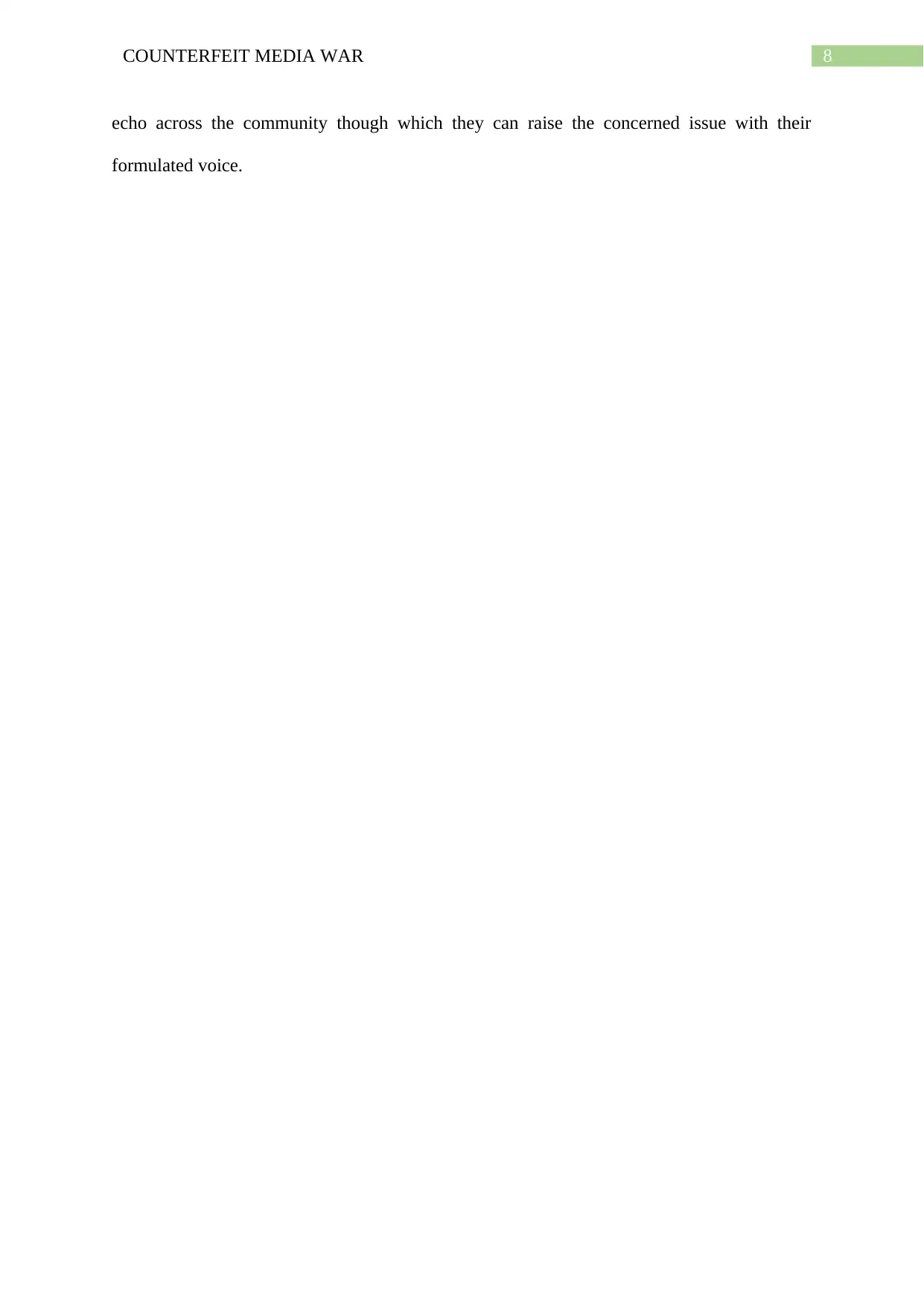
8COUNTERFEIT MEDIA WAR
echo across the community though which they can raise the concerned issue with their
formulated voice.
echo across the community though which they can raise the concerned issue with their
formulated voice.
⊘ This is a preview!⊘
Do you want full access?
Subscribe today to unlock all pages.

Trusted by 1+ million students worldwide
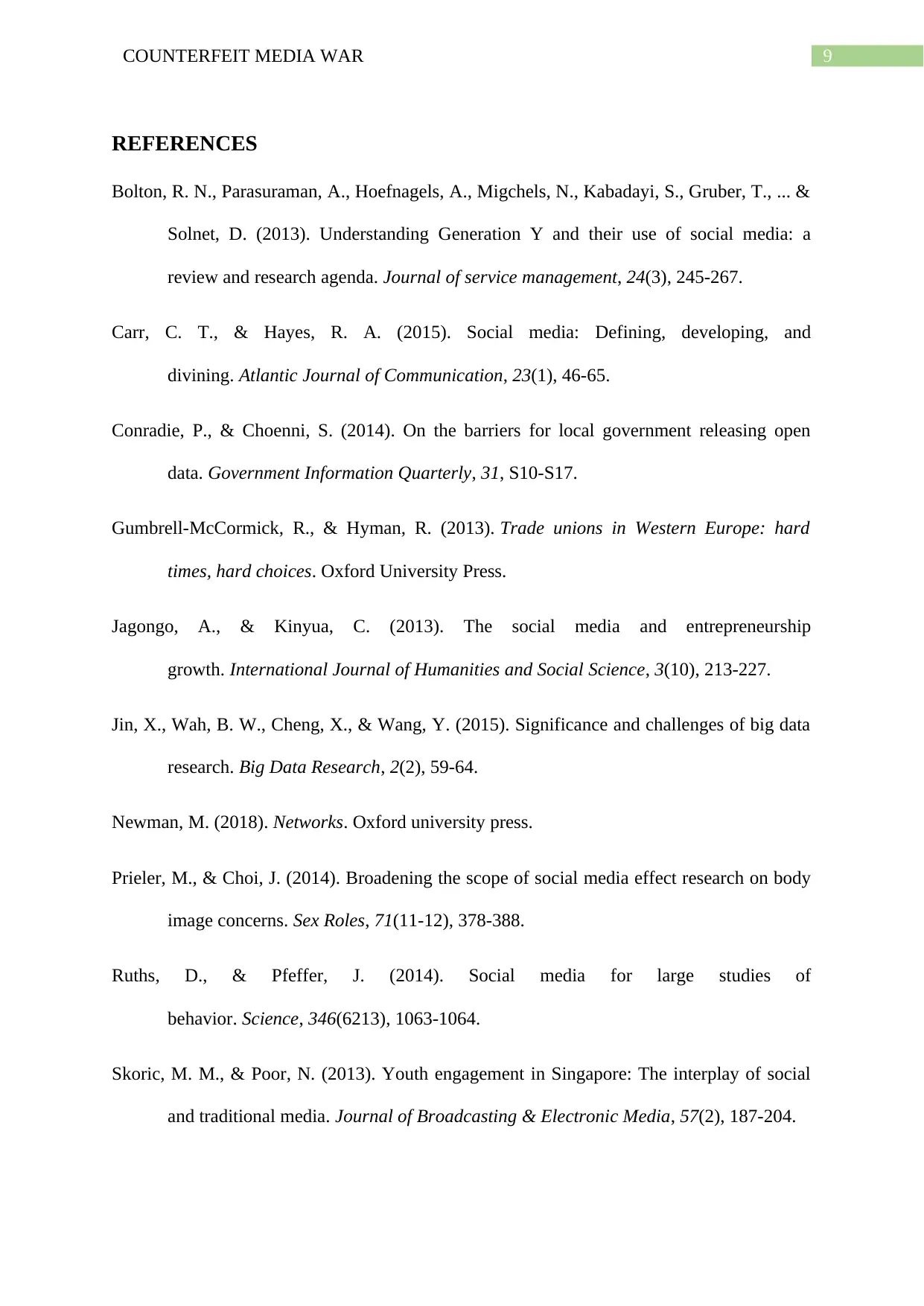
9COUNTERFEIT MEDIA WAR
REFERENCES
Bolton, R. N., Parasuraman, A., Hoefnagels, A., Migchels, N., Kabadayi, S., Gruber, T., ... &
Solnet, D. (2013). Understanding Generation Y and their use of social media: a
review and research agenda. Journal of service management, 24(3), 245-267.
Carr, C. T., & Hayes, R. A. (2015). Social media: Defining, developing, and
divining. Atlantic Journal of Communication, 23(1), 46-65.
Conradie, P., & Choenni, S. (2014). On the barriers for local government releasing open
data. Government Information Quarterly, 31, S10-S17.
Gumbrell-McCormick, R., & Hyman, R. (2013). Trade unions in Western Europe: hard
times, hard choices. Oxford University Press.
Jagongo, A., & Kinyua, C. (2013). The social media and entrepreneurship
growth. International Journal of Humanities and Social Science, 3(10), 213-227.
Jin, X., Wah, B. W., Cheng, X., & Wang, Y. (2015). Significance and challenges of big data
research. Big Data Research, 2(2), 59-64.
Newman, M. (2018). Networks. Oxford university press.
Prieler, M., & Choi, J. (2014). Broadening the scope of social media effect research on body
image concerns. Sex Roles, 71(11-12), 378-388.
Ruths, D., & Pfeffer, J. (2014). Social media for large studies of
behavior. Science, 346(6213), 1063-1064.
Skoric, M. M., & Poor, N. (2013). Youth engagement in Singapore: The interplay of social
and traditional media. Journal of Broadcasting & Electronic Media, 57(2), 187-204.
REFERENCES
Bolton, R. N., Parasuraman, A., Hoefnagels, A., Migchels, N., Kabadayi, S., Gruber, T., ... &
Solnet, D. (2013). Understanding Generation Y and their use of social media: a
review and research agenda. Journal of service management, 24(3), 245-267.
Carr, C. T., & Hayes, R. A. (2015). Social media: Defining, developing, and
divining. Atlantic Journal of Communication, 23(1), 46-65.
Conradie, P., & Choenni, S. (2014). On the barriers for local government releasing open
data. Government Information Quarterly, 31, S10-S17.
Gumbrell-McCormick, R., & Hyman, R. (2013). Trade unions in Western Europe: hard
times, hard choices. Oxford University Press.
Jagongo, A., & Kinyua, C. (2013). The social media and entrepreneurship
growth. International Journal of Humanities and Social Science, 3(10), 213-227.
Jin, X., Wah, B. W., Cheng, X., & Wang, Y. (2015). Significance and challenges of big data
research. Big Data Research, 2(2), 59-64.
Newman, M. (2018). Networks. Oxford university press.
Prieler, M., & Choi, J. (2014). Broadening the scope of social media effect research on body
image concerns. Sex Roles, 71(11-12), 378-388.
Ruths, D., & Pfeffer, J. (2014). Social media for large studies of
behavior. Science, 346(6213), 1063-1064.
Skoric, M. M., & Poor, N. (2013). Youth engagement in Singapore: The interplay of social
and traditional media. Journal of Broadcasting & Electronic Media, 57(2), 187-204.
Paraphrase This Document
Need a fresh take? Get an instant paraphrase of this document with our AI Paraphraser
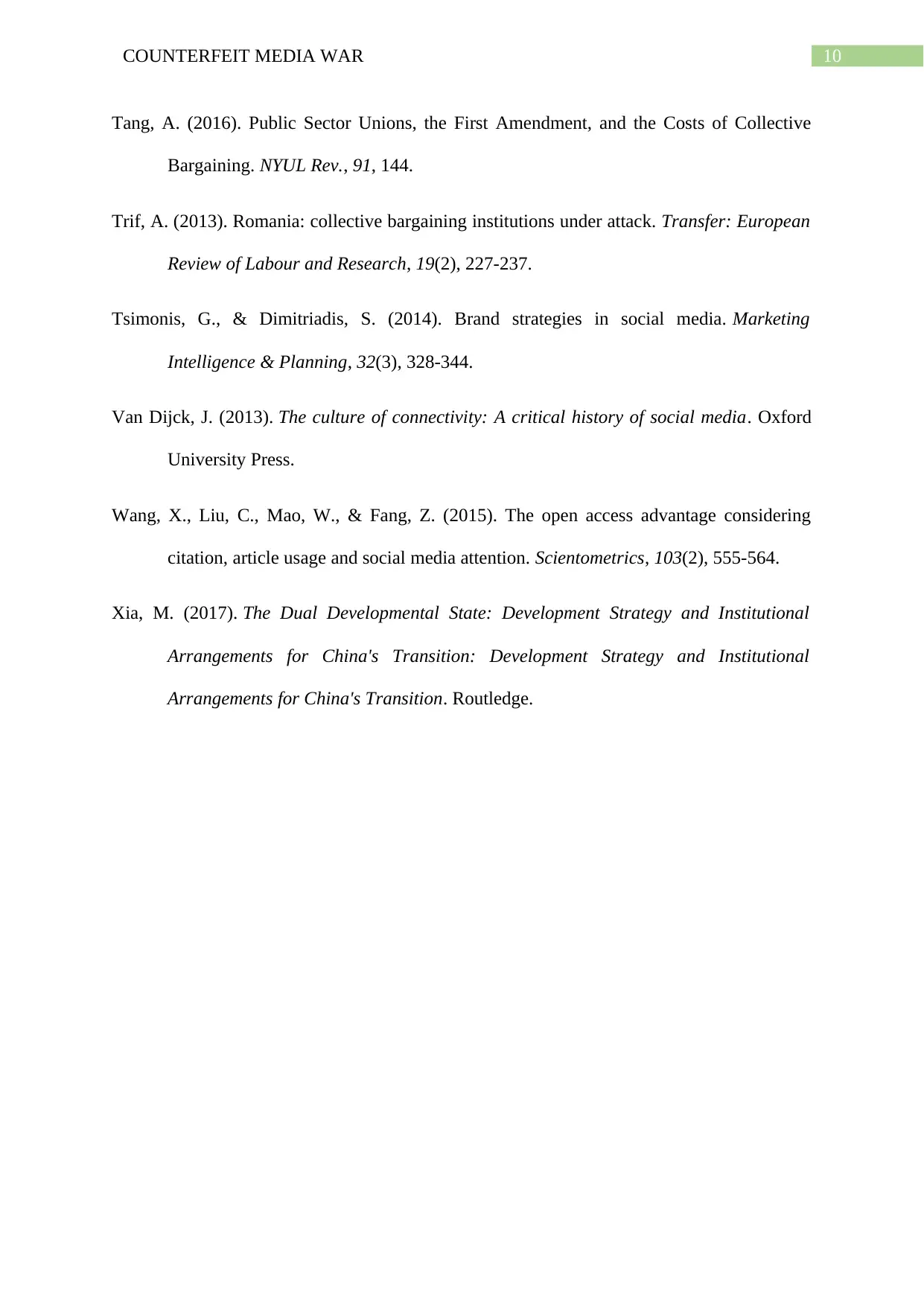
10COUNTERFEIT MEDIA WAR
Tang, A. (2016). Public Sector Unions, the First Amendment, and the Costs of Collective
Bargaining. NYUL Rev., 91, 144.
Trif, A. (2013). Romania: collective bargaining institutions under attack. Transfer: European
Review of Labour and Research, 19(2), 227-237.
Tsimonis, G., & Dimitriadis, S. (2014). Brand strategies in social media. Marketing
Intelligence & Planning, 32(3), 328-344.
Van Dijck, J. (2013). The culture of connectivity: A critical history of social media. Oxford
University Press.
Wang, X., Liu, C., Mao, W., & Fang, Z. (2015). The open access advantage considering
citation, article usage and social media attention. Scientometrics, 103(2), 555-564.
Xia, M. (2017). The Dual Developmental State: Development Strategy and Institutional
Arrangements for China's Transition: Development Strategy and Institutional
Arrangements for China's Transition. Routledge.
Tang, A. (2016). Public Sector Unions, the First Amendment, and the Costs of Collective
Bargaining. NYUL Rev., 91, 144.
Trif, A. (2013). Romania: collective bargaining institutions under attack. Transfer: European
Review of Labour and Research, 19(2), 227-237.
Tsimonis, G., & Dimitriadis, S. (2014). Brand strategies in social media. Marketing
Intelligence & Planning, 32(3), 328-344.
Van Dijck, J. (2013). The culture of connectivity: A critical history of social media. Oxford
University Press.
Wang, X., Liu, C., Mao, W., & Fang, Z. (2015). The open access advantage considering
citation, article usage and social media attention. Scientometrics, 103(2), 555-564.
Xia, M. (2017). The Dual Developmental State: Development Strategy and Institutional
Arrangements for China's Transition: Development Strategy and Institutional
Arrangements for China's Transition. Routledge.
1 out of 11
Related Documents
Your All-in-One AI-Powered Toolkit for Academic Success.
+13062052269
info@desklib.com
Available 24*7 on WhatsApp / Email
![[object Object]](/_next/static/media/star-bottom.7253800d.svg)
Unlock your academic potential
Copyright © 2020–2025 A2Z Services. All Rights Reserved. Developed and managed by ZUCOL.




